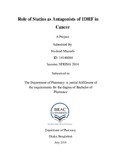| dc.description.abstract | Cancer involves the uncontrollable and abnormal proliferation of cells in the body and is among the leading causes of deaths worldwide. The enzyme, dihydrofolate reductase (DHFR) referred to as 1DHF functions as a precursor for the biosynthesis of purine and pyrimidine bases and is critical for the de novo synthesis of DNA. Maintenance of the normal levels of folate is extremely important, since disruption in the folate metabolism pathway has a lethal effect on rapidly proliferating cells, such as the bone marrow and red blood cells particularly because the normal cell division process gets hampered. A key feature of cancer cells is abnormal cell division or cell mitosis. 1DHF is highly expressed in cancer cells, which makes it a potential target for anti-cancer drug development. A positive correlation between cholesterol accumulation and cancer provide insights into further investigation of anti-cancer indication of statin drugs. In this study, data science, drug repurposing, and other in silico computational techniques have been employed to find a potential statin antagonist of 1DHF that would not only lower serum cholesterol levels but also successfully inhibit the folic acid biosynthetic pathway. The merits of drug repurposing include a safer, cost-effective, productive and more efficient drug. Molecular docking of statin drugs with the proteins 1DHF was carried out using PyRx and the drug-protein interactions were identified using Discovery Studio. The structure of the protein was validated using Ramachandran plot, z-scores, Errat and Verify 3D, and a z-score of -9.09 for 1DHF was obtained. The potential statin small molecules chosen were Pravastatin, Pitavastatin, Rosuvastatin and Simvastatin. Amongst these small molecules, Pitavastatin showed the highest binding affinity (-12.7Kcal/Mol) which indicates that Pitavastatin may possibly reduce the risk of cancer development. It may be given as an adjunct drug to cancer patients, with high levels of LDL, with their anti-cancer therapy. The main aim of this study was to find a statin drug that targeted 1DHF in the treatment of cancer and the statin drug Pitavastatin demonstrated such effect; however, they are required in doses much higher than that of patients receiving the usual statin treatment for hypercholesterolemia. Due to the advantages associated with drug repositioning, it is widely used. The study shows that the statin drug Pitavastatin, may have significant anti-cancer property as they bind with 1DHF with a high binding affinity. Thus,drug repositioning may be used in combination with other oncology therapeutics to obtain a credible drug treatment by causing necrosis of malignant cells. | en_US |

